1996 PONTIAC GRAND-AM change wheel
[x] Cancel search: change wheelPage 87 of 356

Tilt Wheel (Option)
A tilt steering wheel allows you to adjust the steering
wheel before you drive.
You can also raise it to the highest level to give your
legs more room when
you exit and enter the vehicle.
To tilt the wheel, hold the steering wheel and pull the
lever. Move the steering wheel to a comfortable level,
then release the lever to lock the wheel in place.
Turn SignallMultifunction Lever
The lever on the left side of the steering column
includes your:
Turn Signal and Lane Change Indicator
0 Headlamp High/Low Beam Changer
0 Cruise Control (Option)
2-31
ProCarManuals.com
Page 91 of 356
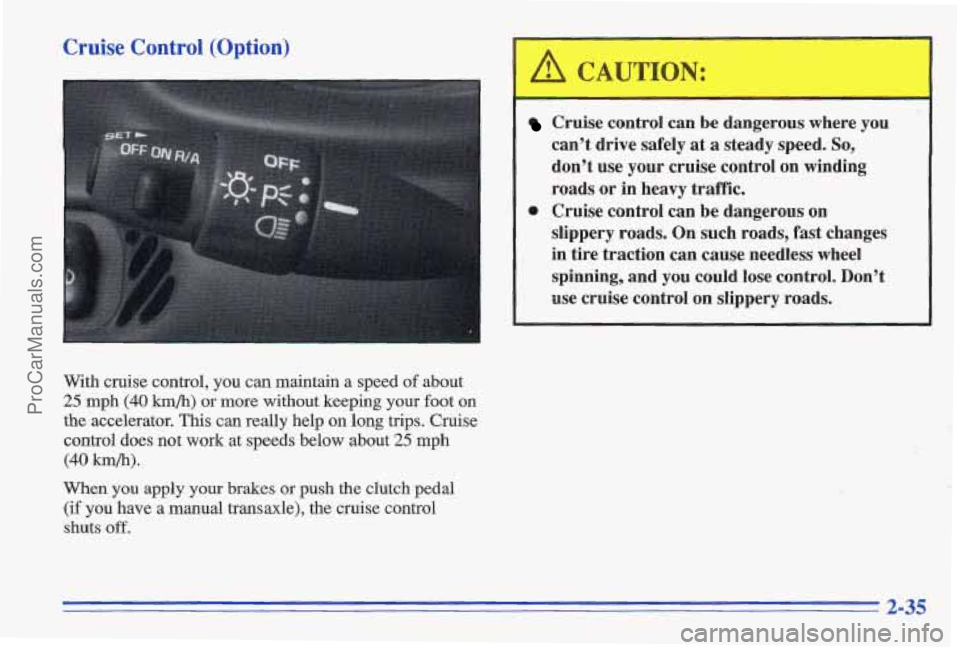
Cruise Control (Option)
With cruise control, you can maintain a speed of about
25 mph (40 h/h) or more without keeping your foot on
the accelerator. This can really help on long trips. Cruise
control does not work at speeds below about
25 mph
(40 hh).
When you apply your brakes or push the clutch pedal
(if you have a manual transaxle), the cruise control
shuts
off.
Cruise control can be dangerous where you
can't drive safely at a steady speed. So,
don't use your cruise control on winding
roads or in heavy traffic.
slippery roads. On such roads, fast changes
in tire traction can cause needless wheel
spinning, and
you could lose control. Don't
use cruise control on slippery roads.
0 Cruise control can be dangerous on
2-35
ProCarManuals.com
Page 155 of 356

The anti-lock system can change the brake pressure
faster than any driver
could. The computer is
programmed to make the most of available tire and road
conditions.
Here’s how anti-lock works. Let’s say the road is wet.
You’re driving safely. Suddenly an animal jumps out in
front
of you.
You slam on the brakes. Here’s what happens with ABS.
A computer senses that wheels are slowing down. If one
of the wheels is about to stop rolling, the computer will
separately
work the brakes at each front wheel and at the
rear wheels. You
can steer around the obstacle
while braking hard.
As you brake, your computer keeps receiving updates on
wheel speed and controls braking pressure accordingly.
4-7
ProCarManuals.com
Page 156 of 356
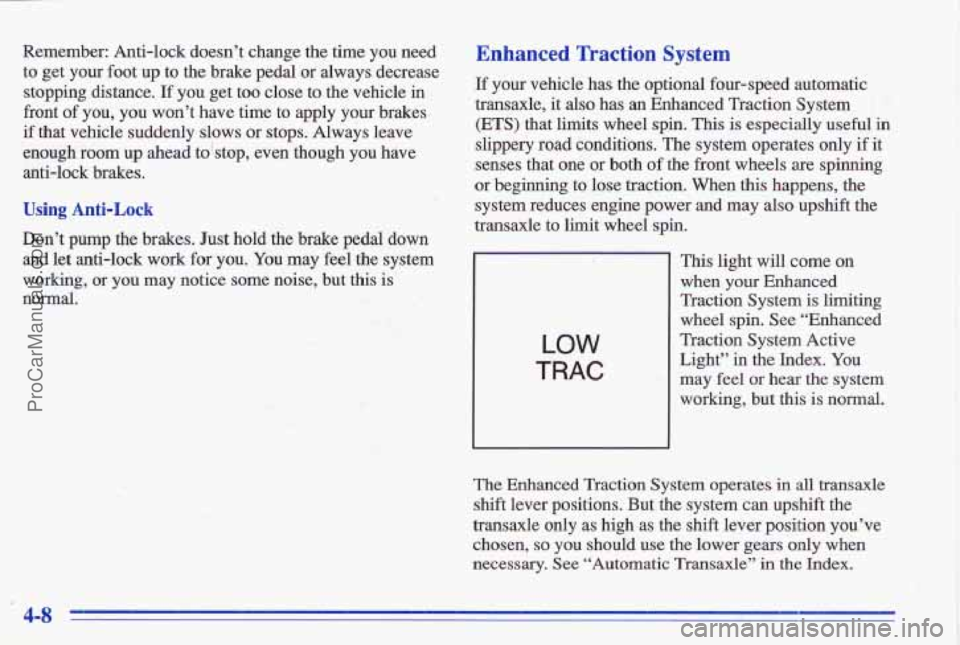
Remember: Anti-lock doesn’t change the time you need
to get your foot up to the brake pedal or always decrease
stopping distance.
If you get too close to the vehicle in
front of you, you won’t have time to apply your brakes.
if that vehicle suddenly slows or stops. Always leave
enough
room up ahead to(stop, even though you hav’e
anti-lock
brakes.
Using AntkLock
Don’t pump the brakes. Just hold the brake pedal down
and let anti-lock work for you.
You may feel the system
working, or you may notice some noise, but this is
normal.
Enhanced Traction System
If your vehicle has the optional four-speed automatic
transaxle, it
also has an Enhanced Traction System
(ETS) that limits wheel spin. This is especially useful in
slippery road condittons. The system operates only if it
senses that one or both of the front wheels we spinning
or beginning to lose traction. When this happens, the
system reduces engine power and may also upshift the
transaxle to limit wheel spin.
I
LOW
TRAC
This light will come on
when your Enhanced
Traction System is limiting
wheel
spin. See “Enhanced
Traction System Active
Light”
in the Index. You
may feel or hear the system
working, but this
is normal.
The
Enhanced Traction System operates in all transaxle
shift lever positions. But the system can upshift the
transaxle only
as high as the shift lever position you’ve
chosen,
so you should use the lower gears only when
necessary.
See “Automatic Transaxle” in the Index.
4-8 -
ProCarManuals.com
Page 158 of 356
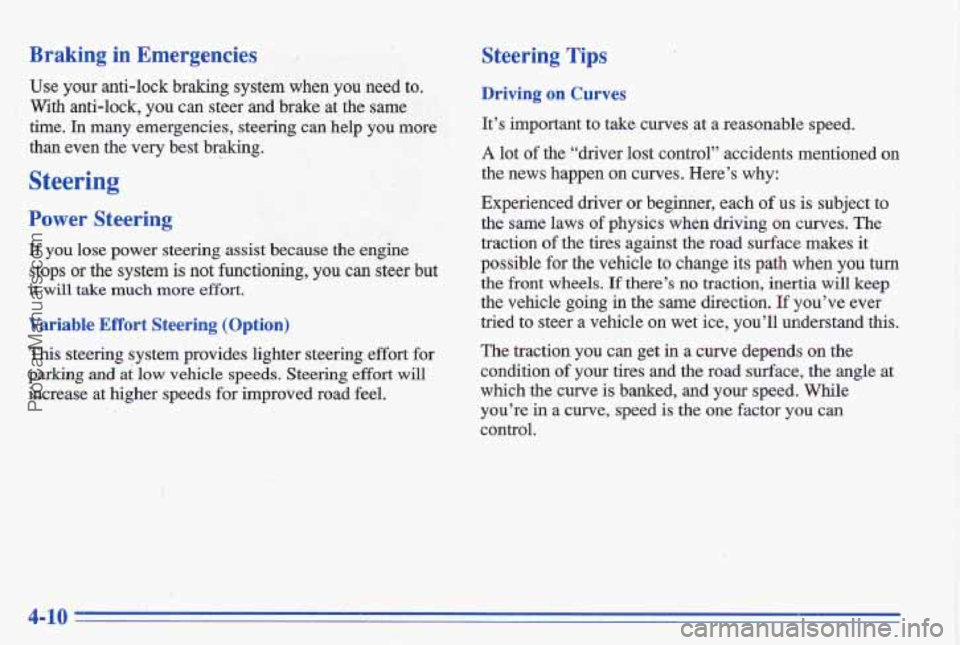
Braking in Emergencies
Use your anti-lock braking system when you need to.
With anti-lock, you can steer and brake at the same
time. Tn many emergencies, steerirzg’cm help you more
thin even the very best braking. -
Steering
Power Steering
If you lose power steering assist because the engine
stops or the system is not functioning,
you can steer but
it will take much more effort.
Variable Effort Steering (Option)
This steering system provides lighter steering effort for
parlcitlg ad at low vehicle speeds. Steering effurt will
increase at higher speeds for improved road feel.
Steering Tips
Driving on Curves
It’s important to take curves at a reasonable speed.
A lot of the “driver lost control” accidents mentioned on
the news happen on curves. Here’s why:
Experienced driver or beginner, each of us is subject to
the same laws
of physics when driving on curves. The
traction
of the tires against the road surface makes it
possible
for the vehicle to change its path when you turn
the front wheels.
If there’s no traction, inertia will keep
the vehicle
going in the same direction. If you’ve ever
tried
to steer a vehicle on wet ice, you’ll understand this.
The traction you can get
in a curve depends on the
condition
of your tires and the road surface, the angle at
which the curve is banked,
and your speed. While
you’re
in a curve, speed is the one factor you can
control.
4-10,
ProCarManuals.com
Page 162 of 356
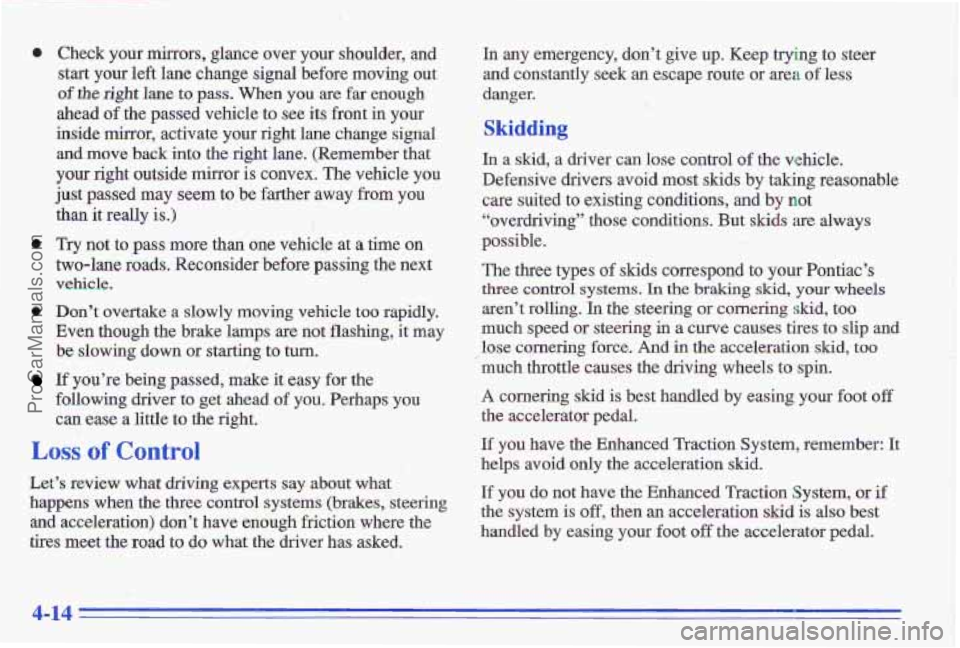
0
0
a
Check your mirrors, glance over your shoulder, and start your left lane change signal before moving out
of the right lane to pass. When you are far enough
ahead
of the passed vehicle to see its front in your
inside mirror, activate your right lane change signal and move back into the right lane. (Remember that
your right outside mirror
is convex. The vehicle you
just passed may seem
to be farther away from you
than it redly is.)
Try not to pass more than one vehicle at a time on
two-lane roads. Reconsider
before passing the next
vehicle.
Don’t overtake a slowly moving vehicle too rapidly.
Even though the brake lamps are not flashing, it may
be slowing down or starting to turn.
If you’re being passed, make it easy for the
following driver to get ahead of you. Perhaps you
can ease a little to the right.
In any emergency, don’t give up. Keep trying to steer
and constantly seek
an escape route or area of less
danger.
Skidding
In a skid, a driver can lose control of the vehicle.
Defensive drivers avoid most skids by
taking reasonable
care suited
to existing conditions, and by not
“overdriving” those conditions. But skids are always
possible.
The three types
of skids correspond to your Pontiac’s
three control systems. In the braking skid, your wheels
aren’t rolling. In the steering or cornering skid, too
much speed or steeiing
in a curve causes tires to slip and
lose cornering force. And
in the acceleration skid, too
much throttle causes the driving wheels to spin.
A cornering
skid is best handled by easing your foot off
the accelerator pedal.
If you have the Enhanced Traction System, remember: It
helps avoid only the acceleration skid.
If you do not have the Enhanced Traction System, or if
the system is off, then an acceleration skid is also best
handled by easing your foot
off the accelerator pedal.
Loss of Control
Let’s review what driving experts say about what
happens
when the three control systems (brakes, steering
and acceleration) don’t have enough friction where the
tires meet the road to do what the driver has asked.
4-14
ProCarManuals.com
Page 182 of 356
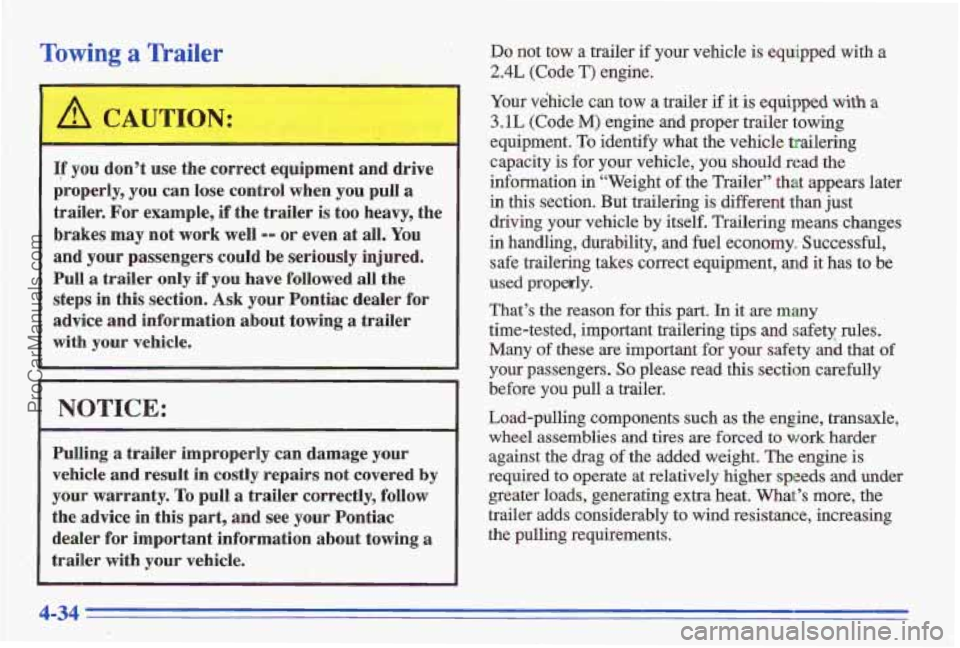
Towing a Trailer
A CAUTION:
If you don't use the correct equipment and drive
properly, you can lose control when
you pull a
trailer. For example, if the trailer is too heavy, the
brakes may not
work well -- or even at all.. You
and your passengers could be seriously injured.
Pull
a trailer only if you have followed all the
steps in this section.
Ask your Pontiac dealer for
advice and information about towing
a trailer
with your vehicle.
Pulling
a traikr improperly can damage your
vehicle and result in costly repairs not covered
by
your warranty. To pull a trailer correctly, follow
the advice in this part, and
see yumr Pontiac
dealer for important information about towing
a
trailer with your vehicle.
Bo not tow a trailer if your vehicle is equipped with a
2.4L (Code T) engine.
Your vehicle can tow a trailer if it is equipped with a
3.1L (Code M) -engine and proper trailer towing
equipment,
To identify what the vehicle trailering
capacity
is for your vehicle, you should read the
information
in "Weight of the Trailer'' that appears later
in this section. But trailering is different than just
driving your vehicle
by itself. Trailering means changes
in handling, durability, md fuel economy. Successful,
safe trailering takes correct equipment, and it has to be
used propetly.
That's the reason for this
part. In it are many
time-tested, important trailering tips and safe% rules.
Many of these are important for your safety and that of
your passengers. So please read this section carefully
before you pull a trailer.
Load-pulling components such as the engine, transaxle,
wheel assemblies and tires are forced to work harder
against
the drag of the added weight. The engine is
required to operate at relatively
higher speeds and under
greater loads, generating extra heat. What,'s more, the
trailer adds considerably to wind resistance, increasing
the gulling requjsernents.
1'
4-34
ProCarManuals.com
Page 187 of 356
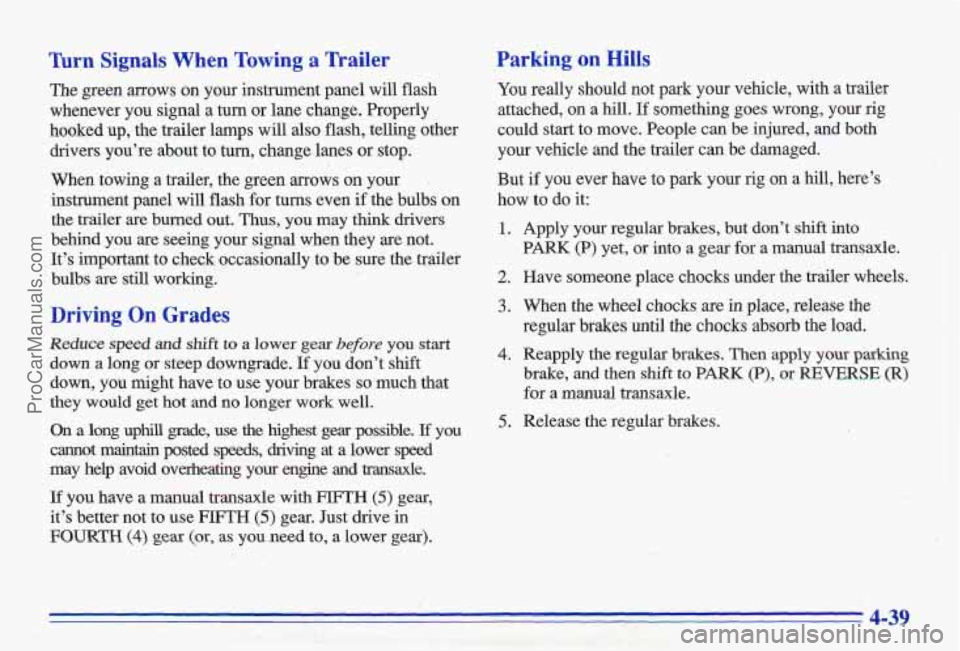
Turn Signals When Towing a Trailer
The green arrows on your instrument panel will flash
whenever you signal a turn or lane change. Properly
hooked up, the trailer lamps
will also flash, telling other
drivers you’re about to
turn, change lanes or stop.
When towing a trailer, the green arrows
on your ’.
instrument panel will flash for turns even if the bulbs on
the trailer are burned out. Thus, you may think drivers
behind you are seeing your signal when they are not.
It’s important to check occasionally to be sure the trailer
bulbs are still working.
Driving On Grades
Reduce speed and shift to a lower gear before you start
down a long or steep downgrade. If you don’t shift
down, you might have to use your brakes
so much that
they would
get hot and no longer work well.
On a long uphill grade, use the highest gear possible. If you
cannot maintain posted speeds, driving at a lower speed
may help avoid overheating your engine and bxmsaxle.
If you have a manual transaxle with FWTH (5) gear,
it’s better not to use
FIFTH (5) gear. Just drive in
FOURTH (4) gear (or- as vou need to, a lower gear).
Parking on Hills
You really should not park your vehicle, with a trailer
attached, on a
hill. If something goes wrong, your rig
could start to move. People can be injured, and both
your vehicle and the trailer can be damaged.
But if you ever have to park your rig on a hill, here’s
how to
do it:
1.
2.
3.
4.
5.
Apply your regular brakes, but don’t shift into
PARK (P) yet, or into a gear for a manual transaxle.
Have someone place chocks under the trailer wheels. When the wheel chocks are in place, release the
regular brakes until the chocks absorb
the load.
Reapply the regular brakes. Then apply your
parking
brake, and then shift to PARK (P), or REVERSE (R)
for a manual transaxle.
Release the regular brakes.
4-39
ProCarManuals.com